Investor duties are binding legal standards applied to financial professionals who have been contracted to make investment decisions on behalf of others.
While the language and specific requirements vary across jurisdictions and financial regulatory authorities, the basic, underlying duties for all investors generally include the duty of prudence and the duty of loyalty:
-
The duty of prudence: investors should act with due care, skill, and diligence, investing as any prudent investor would.
-
The duty of loyalty: investors should act honestly and in good faith, investing in the interests of their clients or beneficiaries, should impartially manage all conflicts of interest of different clients or beneficiaries, should not favor one beneficiary or their interests over another, and should not act to benefit their own interests.[1]
The duties focus on the investor’s intent or the investment process rather than the result. The fulfilment of duties is evaluated on whether the investor operated reasonably.2 Asset owners normally communicate their investment beliefs, objectives, expectations, and risk appetite in mandates or investment management agreements to inform investment activities undertaken on their behalf.
A key factor in fulfilling investor duties is considering material factors that could impact the risk and return profile of an investment over a designated time horizon. An investor’s assessments of materiality are objective, there is no fixed approach. Materiality depends on the investment objectives, time horizons, industry dynamics, and risk tolerance of the client or beneficiary. To fulfill their duties, investors should consider each investment’s unique characteristics and their client’s or beneficiaries’ objectives when assessing materiality.3 What may be material to one investment or portfolio may not be relevant to another, depending on the circumstances. Material factors could include regulatory, financial and reputational risks, industry, geopolitical, and macroeconomic trends, and non-diversifiable, system-level risks.
Investor duties, and the concept of materiality, are fluid as they may evolve in response to shifts in industry understanding of new information and market conditions. For example, following the 2008 global financial crisis, there was an increased understanding of the materiality of macroeconomic trends, liquidity risks, and corporate governance practices. As the understanding of materiality evolves, so too does the duty of an investor to act with due care, skill, and diligence.
The expansion of investor duty
2005: A legal framework for the integration of ESG issues into institutional investment
In the early 2000s, investors began to increasingly understand the significance of ESG factors on investment decision-making. The legal firm Freshfields, in coordination with UNEP FI, published a report that found investors are permitted to incorporate financially material ESG issues as part of their investor duties.
2009: Legal and practical aspects of integrating ESG issues into institutional investment
Freshfields and UNEP FI published a follow-on report that provided legal perspective on how best to carry out the integration of ESG factors into the investment process, with respect to investment mandates and investment management contracts.
2015 - 2019: Fiduciary Duty in the 21st Century
PRI and UNEP FI, with support from The Generation Foundation, undertook a four-year project to clarify investor obligations and duties in relation to ESG issues. The project concluded that ESG factors should be considered as material factors to prudent investor.
2021: A Legal Framework for Impact
This most recent report published by Freshfields, in partnership with PRI, UNEP FI and The Generation Foundation, analysed whether and how legal frameworks around the world allow investors to consider sustainability impact. The findings showed that investors are likely to be required to consider and act on sustainability outcomes where doing so could be effective in achieving their financial goals.
In a more complex, ever-changing world, investors are doing important and diligent work to better understand all factors that may impact the risk and return profiles of their investments. There has been significant growth in active ownership practices and stewardship activities to better understand the risks posed to their investee companies. There are new approaches and frameworks to assess factors that may impact the financial objectives of their investments. Today, investors understand they should consider the total mix of relevant information available to them when making investment decisions.
Market expectations are further driving investors to enhance their engagement on issues around the sustainability of investments and broader financial markets – including factors of environmental, social, governance and broader system-level nature. Beneficiaries and clients are demanding greater clarity on how their assets are managed, including how investors are actively mitigating such risks. As a result, investors who fail to meet these expectations may face reputational and legal risks that could ultimately undermine their ability to fulfill their financial obligations.
NB: This article was updated on 10/04/2025.
References
[1] Hawley, J., Johnson, K., Waitzer, E., (2011).Reclaiming Fiduciary Duty Balance, Rotman International Journal of Pension Management.










